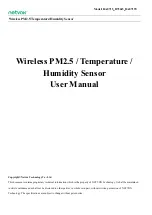
Getting Started
3-8
3.4.3 Connections — instruments to columns
An alternate connection scheme of the long, narrow matrix
has all connections on the columns, both instruments and
DUTs. This type of connection scheme is usually used in an
expanded switching matrix (refer to paragraph 3.5) when the
series of tests requires a large number of instruments and
DUTs, with only a few signals for each test. As shown in Fig-
ure 3-8, with two cards, two crosspoint relays must be closed
to complete a path from column-column (a safety benefit
when sourcing). Multiple crosspoint paths, when compared
with single crosspoint paths, have additional path resistance
and contact potential.
Crosspoint programming becomes more complex with
column-column paths because of the number of possible
paths for large matrices and the choice of rows to complete
the path (refer to Table 3-5).
Table 3-5
Row-column and column-column paths
Crosspoints
per path
1
Possible
paths for 8
rows
×
12
columns
Possible
paths for 8
rows
×
60
columns
Row-column
Column-column
2
1
2
96
66
480
1830
Notes:
1. The crosspoints per path do not account for any isolator relays present
on a card.
2. Each column-column path can be made through one of eight rows
(e.g., column 1 can be connected to column 2 by any of the following:
closing A1 and A2, B1 and B2, C1 and C2, etc.).
The row completion choice for column-column paths on
multiple application cards follows the recommendations giv-
en previously for row-column paths. With a Model 7072
card, close a crosspoint relay in row A or B for low current
applications, row C, D, E, or F for general purpose switch-
ing, and row F or G for C-V switching.
3.4.4 Connections — partial matrix expansion
External expansion of the cards can also be used to imple-
ment a partial matrix. As shown in Figure 3-9 (Model 7071
cards), a column connection is made between unit 3 and unit
4. With the example connections shown, three crosspoints
must be closed to source (increasing the safety factor), but
only one crosspoint closure is needed to measure (recom-
mended for sensitive instruments).
3.4.5 Multiple application cards
Selecting the correct row connections for instruments is im-
portant with cards designed for multiple applications. Using
the Model 7072 as an example, the recommended connec-
tions are:
• Rows A and B (low current) — Picoammeters, elec-
trometers.
• Rows C through F (general purpose) — DMMs, sourc-
es.
• Rows G and H (C-V characteristics) — C-V analyzers.
Artisan Technology Group - Quality Instrumentation ... Guaranteed | (888) 88-SOURCE | www.artisantg.com
Summary of Contents for 708A
Page 135: ...Artisan Technology Group Quality Instrumentation Guaranteed 888 88 SOURCE www artisantg com ...
Page 136: ...Artisan Technology Group Quality Instrumentation Guaranteed 888 88 SOURCE www artisantg com ...
Page 137: ...Artisan Technology Group Quality Instrumentation Guaranteed 888 88 SOURCE www artisantg com ...
Page 138: ...Artisan Technology Group Quality Instrumentation Guaranteed 888 88 SOURCE www artisantg com ...
Page 139: ...Artisan Technology Group Quality Instrumentation Guaranteed 888 88 SOURCE www artisantg com ...
Page 145: ...Artisan Technology Group Quality Instrumentation Guaranteed 888 88 SOURCE www artisantg com ...
Page 146: ...Artisan Technology Group Quality Instrumentation Guaranteed 888 88 SOURCE www artisantg com ...
Page 147: ...Artisan Technology Group Quality Instrumentation Guaranteed 888 88 SOURCE www artisantg com ...
Page 148: ...Artisan Technology Group Quality Instrumentation Guaranteed 888 88 SOURCE www artisantg com ...
Page 149: ...Artisan Technology Group Quality Instrumentation Guaranteed 888 88 SOURCE www artisantg com ...
Page 150: ...Artisan Technology Group Quality Instrumentation Guaranteed 888 88 SOURCE www artisantg com ...
















































